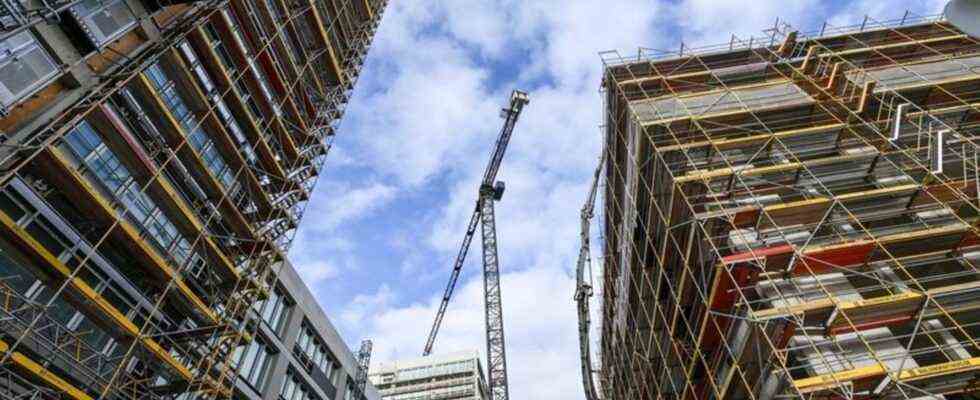Houses and flats
House prices are rising at record pace – warning of bubble
The pandemic did not stop the real estate boom in Germany either – to the chagrin of tenants and home buyers. Photo: Jens Kalaene / dpa-Zentralbild / dpa
© dpa-infocom GmbH
Residential real estate is becoming more expensive than it has been in a good 20 years. In rural areas, too, prices are rising rapidly. Economists are warning of a price bubble in some major cities – once again.
The prices for residential real estate in Germany are rising at record speed. In the third quarter, apartments and houses increased in price by an average of 12 percent compared to the same period last year, as the Federal Statistical Office announced on Wednesday.
For the second time in a row, this is the largest price increase since the start of the time series in 2000. Prices are skyrocketing not only in large cities, but also in rural areas.
The Wiesbaden statisticians had already calculated an increase of 10.8 percent in the second quarter – this rate has now been exceeded despite the Corona crisis. The boom alarmed economists: The German Institute for Economic Research (DIW) warned of the bursting of real estate bubbles in some cities.
The Federal Office found an increase of 14.5 percent for houses and apartments in the seven largest cities of Berlin, Hamburg, Munich, Cologne, Frankfurt, Stuttgart and Düsseldorf. But prices also rose rapidly in sparsely populated rural districts: there, one and two-family houses were up 15.5 percent compared to the same quarter of the previous year and condominiums by 11.2 percent.
In more densely populated rural districts, apartment and house prices also rose sharply: single and two-family houses cost an average of 12 percent more than in the same quarter of the previous year and condominiums 12.3 percent.
Many factors for rising prices
Low interest rates, limited living space, a lack of investment alternatives, especially for large investors, and a robust economy have been driving the real estate boom for a long time. At the same time, expensive materials such as wood, cement and steel as well as scarce capacities in the construction industry are driving up construction prices. With the pandemic and the trend towards home offices, real estate is also increasingly in demand in rural areas.
After more than a decade of rising prices, the DIW now believes that major “price corrections” in Berlin, Munich, Hamburg, but also in other large cities and university towns are possible in the coming years. There could be falling but also stagnating prices, said study author Konstantin Kholodilin. The speculative exaggerations would increase. Condominiums and building plots in large cities are particularly affected.
“There are increasing signs that house prices in some cities and market segments can no longer be explained solely by the development of rents and low interest rates,” explained Kholodilin. “There may be price corrections there in the next few years, in other words, property price bubbles may burst.” However, the experience of other countries shows that when a bubble bursts, prices do not fall as low as they were before.
The DIW evaluated data from the 114 largest German cities. Purchase prices for home ownership rose by nine percent this year, while rents grew by about half as much. The trend of the ten previous years thus continued. The increasing divergence indicates speculative bubbles, it said. In many cases, explosive patterns in price developments emerged.
No danger to the financial system
However, the risk of a nationwide real estate bubble is manageable. Overall, houses are solidly financed. There is nothing to indicate a threat to financial stability from bursting price bubbles. In addition, the gap between supply and demand on the housing market will narrow.
There have been many warnings of bubbles in the real estate boom – but prices kept rising. From 2010 to 2020, used condominiums rose by 85 percent and single and two-family houses by 75 percent, as the market report of the official appraisal committees recently showed. They also consider the markets in the metropolises to be overheated. Prices have also increased significantly on the North and Baltic Seas and in the Alpine foothills.
The Bundesbank has also been warning of overheating for years. “According to our calculations, the prices of residential properties are 10 to 30 percent above the value that is justified by fundamentals. We are increasingly seeing this outside of the metropolitan areas, too, ”said Vice President Claudia Buch in November.
The DIW warned that because of rising prices, the prospect of more and more people was dwindling from their own four walls. Short-time work benefits and other benefits have so far ensured that most households can pay their rent. “In order to prevent upheavals in the real estate market, the state aid to corona should not be scaled back too early,” recommend the economists.

